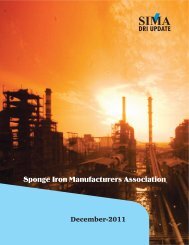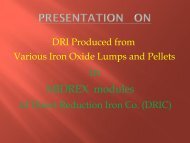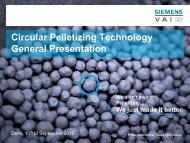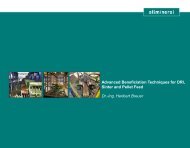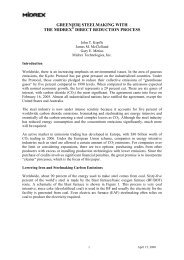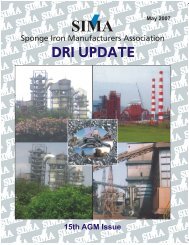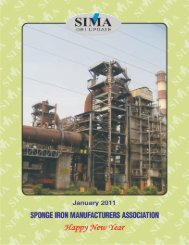Carbon Trading Potential in Indian Sponge Iron Sector - A ...
Carbon Trading Potential in Indian Sponge Iron Sector - A ...
Carbon Trading Potential in Indian Sponge Iron Sector - A ...
Create successful ePaper yourself
Turn your PDF publications into a flip-book with our unique Google optimized e-Paper software.
(i) waste gases from a 200 TPD kiln can produce 4MW power<br />
(ii) 1 MW power, on an average, can attract 3000 CERs annually<br />
By the year 2011-12, with the anticipated doubl<strong>in</strong>g of production of sponge iron through<br />
coal based kilns, power generation and correspond<strong>in</strong>g CERs would also be doubled to<br />
realize a credit of about 3 million CERs annually.<br />
Tak<strong>in</strong>g a case of some realistic recent transactions of CERs at 13.75 Euro per unit, there<br />
is bus<strong>in</strong>ess volume of 41 million Euros annually or about 2250 million rupees per year.<br />
Improv<strong>in</strong>g viability of WHRS<br />
In view of such promise of bus<strong>in</strong>ess, there is a strong case to enhance viability of related<br />
projects for better realization compounded with harness<strong>in</strong>g its full potential. Some of the<br />
suggested measures could be :-<br />
(i) earmark<strong>in</strong>g and allocat<strong>in</strong>g non-cok<strong>in</strong>g coal blocks hav<strong>in</strong>g coal of high ash fusion<br />
temperature and high reactivity exclusively for sponge iron sector. Such coals are better<br />
suited to manufactur<strong>in</strong>g of sponge iron.<br />
ii) allocat<strong>in</strong>g iron ore m<strong>in</strong>es to sponge iron manufacturers to ensure availability of<br />
consistent quality of high grade iron ore feed to kilns. This will lead to higher degree of<br />
metallisation and reduced accretion <strong>in</strong> the kilns with less downtime and hence higher<br />
plant availability.<br />
(iii) permitt<strong>in</strong>g open access and <strong>in</strong>ter-state wheel<strong>in</strong>g of power from sponge iron sector at<br />
a reasonable tariff with no h<strong>in</strong>drance.<br />
While on the subject of wheel<strong>in</strong>g power, it is estimated that a waste heat recovery<br />
system based on 350 TPD kiln can generate about 7 MW, out of which 1.5 MW can be<br />
used for captive consumption <strong>in</strong> sponge iron mak<strong>in</strong>g <strong>in</strong> stand-alone sponge iron plants<br />
and a surplus of 5.5 MW can be exported to the grid for trad<strong>in</strong>g. The sponge iron units<br />
graduat<strong>in</strong>g to m<strong>in</strong>i steel plants through forward <strong>in</strong>tegration by employ<strong>in</strong>g <strong>in</strong>duction<br />
furnaces, electric arc furnaces or similar adjuncts would require more power for captive<br />
consumption. Such <strong>in</strong>tegrated plants can use the surplus power cost effectively with self<br />
reliance.<br />
(iv) network<strong>in</strong>g of carbon trad<strong>in</strong>g bus<strong>in</strong>ess through carbon exchanges spread over<br />
strategic locations.<br />
4



